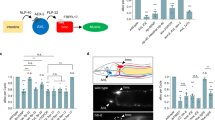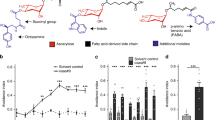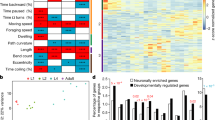Abstract
The Ras-MAPK (mitogen-activated protein kinase) signal transduction pathway is well known to control cellular proliferation and differentiation in response to extracellular signals, but its other functions are less understood. In Caenorhabditis elegans this pathway regulates several developmental events, such as vulval induction and progression of meiosis1, but its function in the nervous system is unknown. Here we report that the Ras-MAPK pathway is involved in olfaction in this organism. Mutational inactivation and hyperactivation of this pathway impairs efficiency of chemotaxis to a set of odorants. Experiments in which let-60 ras was expressed using a heat-shock promoter and a cell-specific promoter show that a normal activity of LET-60 Ras is required in mature olfactory neurons. Application of the odorant isoamylalcohol to wild-type animals leads to the activation of MAP kinase in olfactory neurons within 10 seconds. This induction is dependent on the function of the nucleotide-gated channel TAX-2/TAX-4 and the voltage-activated calcium channel subunit UNC-2. These results suggest a dynamic regulatory role for the Ras-MAPK pathway in perception and transmission of sensory signals in olfactory neurons.
This is a preview of subscription content, access via your institution
Access options
Subscribe to this journal
Receive 51 print issues and online access
$199.00 per year
only $3.90 per issue
Buy this article
- Purchase on Springer Link
- Instant access to full article PDF
Prices may be subject to local taxes which are calculated during checkout




Similar content being viewed by others
References
Sternberg, P. W. & Han, M. Genetics of RAS signaling in C. elegans. Trends Genet. 14, 466–472 (1998).
Bargmann, C. I., Hartwieg, E. & Horvitz, H. R. Odorant-selective genes and neurons mediate olfaction in C. elegans. Cell 74, 515– 527 (1993).
Beitel, G. J., Clark, S. G. & Horvitz, H. R. Caenorhabditis elegans ras gene let-60 acts as a switch in the pathway of vulval induction. Nature 348, 503–509 ( 1990).
Church, D. L., Guan, K. L. & Lambie, E. J. Three genes of the MAP kinase cascade, mek-2, mpk-1/sur-1 and let-60 ras, are required for meiotic cell cycle progression in Caenorhabditis elegans. Development 121, 2525–2535 (1995).
Kornfeld, K., Hom, D. B. & Horvitz, H. R. The ksr-1 gene encodes a novel protein kinase involved in Ras-mediated signaling in C. elegans. Cell 83, 903–913 (1995).
Sundaram, M. & Han, M. The C. elegans ksr-1 gene encodes a novel Raf-related kinase involved in Ras-mediated signal transduction. Cell 83, 889–901 ( 1995).
Clark, S. G., Stern, M. J. & Horvitz, H. R. C. elegans cell-signalling gene sem-5 encodes a protein with SH2 and SH3 domains. Nature 356, 340–344 (1992).
Tan, P. B., Lackner, M. R. & Kim, S. K. MAP kinase signaling specificity mediated by the LIN-1 Ets/LIN-31 WH transcription factor complex during C. elegans vulval induction. Cell 93, 569– 580 (1998).
Yu, S., Avery, L., Baude, E. & Garbers, D. L. Guanylyl cyclase expression in specific sensory neurons: A new family of chemosensory receptors. Proc. Natl Acad. Sci. USA 94, 3384– 3387 (1997).
Coburn, C. M., Mori, I., Ohshima, Y. & Bargmann, C. I. A cyclic nucleotide-gated channel inhibits sensory axon outgrowth in larval and adult Caenorhabditis elegans: a distinct pathway for maintenance of sensory axon structure. Development 125, 249–258 (1998).
Coburn, C. M. & Bargmann, C. I. A putative cyclic nucleotide-gated channel is required for sensory development and function in C. elegans . Neuron 17, 695–706 (1996).
Peckol, E. L., Zellen, J. A., Yarrow, J. C. & Bargmann, C. I. Sensory activity affects sensory axon development in C. elegans. Development 126, 1891–1902 (1999).
Troemel, E. R., Kimmel, B. E. & Bargmann, C. I. Reprogramming chemotaxis responses: sensory neurons define olfactory preferences in C. elegans. Cell 91, 161–169 (1997).
Albertson, D. G. & Thomson, J. N. The pharynx of Caenorhabditis elegans. Phil. Trans. R. Soc. Lond. B Biol. Sci. 275, 299–325 (1976).
Roayaie, K., Crump, J. G., Sagasti, A. & Bargmann, C. I. The G alpha protein ODR-3 mediates olfactory and nociceptive function and controls cilium morphogenesis in C. elegans olfactory neurons. Neuron 20, 55–67 ( 1998).
Komatsu, H., Mori, I., Rhee, J. S., Akaike, N. & Ohshima, Y. Mutations in a cyclic nucleotide-gated channel lead to abnormal thermosensation and chemosensation in C. elegans. Neuron 17, 707–718 ( 1996).
Schafer, W. R. & Kenyon, C. J. A calcium-channel homologue required for adaptation to dopamine and serotonin in Caenorhabditis elegans. Nature 375, 73– 78 (1995).
Schild, D. & Restrepo, D. Transduction mechanisms in vertebrate olfactory receptor cells. Physiol. Rev. 78, 429–466 (1998).
Prasad, B. C. & Reed, R. R. Chemosensation: molecular mechanisms in worms and mammals. Trends Genet. 15, 150–153 (1999).
Bargmann, C. I. Neurobiology of the Caenorhabditis elegans genome. Science 282, 2028–2033 ( 1998).
Goodman, M. B., Hall, D. H., Avery, L. & Lockery, S. R. Active currents regulate sensitivity and dynamic range in C. elegans neurons. Neuron 20, 763–772 ( 1998).
Finkbeiner, S. & Greenberg, M. E. Ca2+-dependent routes to Ras: mechanisms for neuronal survival, differentiation, and plasticity? Neuron 16, 233– 236 (1996).
Farnsworth, C. L. et al. Calcium activation of Ras mediated by neuronal exchange factor Ras–GRF. Nature 376, 524– 527 (1995).
Brambilla, R. et al. A role for the Ras signalling pathway in synaptic transmission and long-term memory. Nature 390, 281– 286 (1997).
Dusenbery, D. B., Sheridan, R. E. & Russell, R. L. Chemotaxis-defective mutants of the nematode Caenorhabditis elegans. Genetics 80, 297–309 (1975).
Bargmann, C. I. & Horvitz, H. R. Chemosensory neurons with overlapping functions direct chemotaxis to multiple chemicals in C. elegans. Neuron 7, 729– 742 (1991).
Mello, C. C., Kramer, J. M., Stinchcomb, D. & Ambros, V. Efficient gene transfer in C. elegans: extrachromosomal maintenance and integration of transforming sequences. EMBO J. 10, 3959–3970 (1991).
Nonet, M. L. et al. Caenorhabditis elegans rab-3 mutant synapses exhibit impaired function and are partially depleted of vesicles. J. Neurosci. 17, 8061–8073 ( 1997).
Yung, Y. et al. Detection of ERK activation by a novel monoclonal antibody. FEBS Lett. 408, 292–296 (1997).
Acknowledgements
We thank D. Garbers for the gcy-10::GFP reporter plasmid; M. Han for let-60 cDNAs and the mek-2(ku114) strain; M. Koga, Y. Ohshima, N. Hisamoto and K. Matsumoto for pEF1α::GFP; A. Fire for vectors; and C. Bargmann, T. Schedl and Y. Emori for their comments and advice. All other nematode strains used in this study were provided by the Caenorhabditis Genetics Center, which is funded by the NIH National Center for Research Resources (NCRR).
Author information
Authors and Affiliations
Corresponding author
Rights and permissions
About this article
Cite this article
Hirotsu, T., Saeki, S., Yamamoto, M. et al. The Ras-MAPK pathway is important for olfaction in Caenorhabditis elegans. Nature 404, 289–293 (2000). https://doi.org/10.1038/35005101
Received:
Accepted:
Issue Date:
DOI: https://doi.org/10.1038/35005101
This article is cited by
-
Comparative proteomic analysis of olfactory rosettes in anadromous Coilia nasus and resident Coilia nasus
Journal of Oceanology and Limnology (2019)
-
Development of transgenic Caenorhabditis elegans expressing human transthyretin as a model for drug screening
Scientific Reports (2018)
-
A role for Ras in inhibiting circular foraging behavior as revealed by a new method for time and cell-specific RNAi
BMC Biology (2015)
-
Distinct roles of the RasGAP family proteins in C. elegans associative learning and memory
Scientific Reports (2015)
-
Light and pheromone-sensing neurons regulates cold habituation through insulin signalling in Caenorhabditis elegans
Nature Communications (2014)
Comments
By submitting a comment you agree to abide by our Terms and Community Guidelines. If you find something abusive or that does not comply with our terms or guidelines please flag it as inappropriate.



